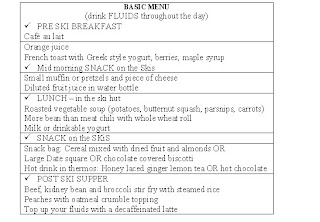The most successful loppet skiers rely on quality training and attention to nutritional details, including
• Adequate hydration and electrolyte replacement;
• A diet of whole foods (not supplements), emphasizing vegetables and fruits, whole grains, legumes and low fat sources of protein rich foods;
• Timing of pre and post workout snacks and meals; and
• Using optimal foods and fluids throughout training and race situations.
Match your eating and drinking to your training
You should be in your ready to race phase as you wind up for your 2011 loppet. So make sure that your energy and fuel requirements are being met with the right amount of foods and fluids to support your training and loppet day performance.
How do you know if you are eating enough?
You should remain energized throughout your training. Any dips in energy levels and/or performance means that something is missing – are you drinking enough and are you strategically sneaking in those carbohydrate rich foods at meals, snacks and during training? Here is a typical day of carbohydrate rich eating when you are out all day on your skis:
Recovery between training sessions is essential
Optimizing recovery is where most masters’ athletes do poorly. Recovery is the MOST IMPORTANT part of your training and race day preparation program. If you do not get adequate recovery (rest, refueling, rehydration) your body will break down. This shows up as compromised immune function (you get sick), injury, loss of power, strength and endurance, poor performance OR a lack of performance improvement, and/or an overall sense of malaise/fatigue.
Tips for Optimizing Recovery
1. Maintain a well- balanced diet but eat more food on the days when you train more.
2. Eat more frequently. Frequent feeding will keep you in the best possible energy balance for health and performance.
3. Include food sources of protein with each meal/snack (see chart below).
4. Refuel with carbohydrate and protein combinations after working out (see chart below).
5. Weight yourself before and after training and replace lost weight with similar weight of fluids over the next 8 hour.
6. SLEEP! Cat nap during the day if you can’t get enough sleep at night.
7. After your toughest workouts take the next day off and do light activity only. Older athletes (60 yrs +) may need to take 2 days off training to optimize recovery after high volume or high intensity workouts.
Wednesday, January 19, 2011
Subscribe to:
Post Comments (Atom)




Thanks for all the info I will tell this to my friends
ReplyDelete__________________
Freelancer
This web diary is contrast interesting Very capably made information. It will be huge to everyone who uses it, including myself. Thankful Hi!This is particularly useful post for everyone. Thankful to you so much this post.Just about everything looks incredible appeared
ReplyDeletesilver jewelry wholesale
Much thanks to you for examining your weblog webpage here and you truly gave me inspiration and you empower me on this distribute. Trusting you will have some post with respect to some guidance for an understudies that urge the understudies to compose the books on various points
ReplyDelete3D rendering services
I truly favor to reading your post. Thank you a lot for taking the time for you to share such a nice info.
ReplyDelete______________________
Weight loss diet plan